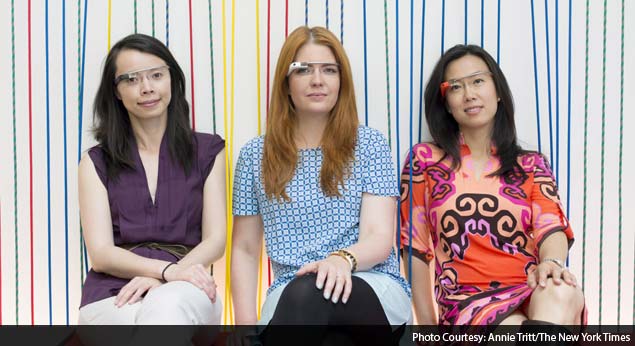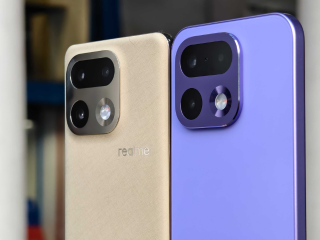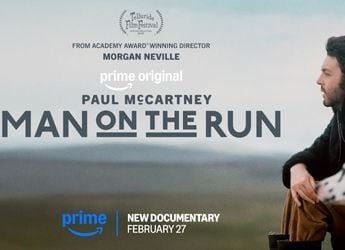- Home
- Others
- Others News
- For the women of Google, the Glass has no ceiling
For the women of Google, the Glass has no ceiling

Instead, she was nervous about color.
The current palette for the frames of Glass, the Internet-connected eyewear, is limited: cotton (white), tangerine (orange), sky (blue) and two shades of gray. Although wearing a pop of turquoise or coral on your face might fly in Silicon Valley, Olsson worried they would clash on the runway.
But when she entered the studio days before Fashion Week last fall, she saw coral crepe tunics and flowing turquoise pants. The styles, which von Furstenberg described as "rebel princess," just happened to be the same palette as Glass, despite being conceived long before the designer discovered the gadget.
A week later, one model matched a tangerine Glass to the orange architectural squiggle on a jumpsuit, and another paired a sky Glass to a turquoise slouchy tank and bag. When von Furstenberg took her call at the end, she wore tangerine. On her arm was Sergey Brin, Google's co-founder, in sky.
"I love color, so I knew it was important, but not the extent to which it is about the emotional connection," said Olsson, who trained in Sweden and whose job interview at Google, in which she did not know the secret project she would be working on, included questions like, "Do you like yellow?"
Olsson, 30, is one of a group of women charged by the company with turning Glass into the next It accessory. If high fashion and high tech are worlds apart, the women of Google Glass are like explorers, trying to connect the two.
They are also pushing another boundary, as senior women in tech, where men still outnumber women three to one. The disparity is even more extreme among engineers. Yet at Glass, women are leading hardware and business efforts for one of Google's biggest-ever product gambles.
Along with Olsson, the team includes Jean Wang, 33, a hardware engineer in charge of Glass features like optics and acoustics, and Kelly Liang, 39, the director of business development, who oversees partnerships with app developers and others.
In an interview over a luau-style lunch at the company headquarters here, the three said they do not give much thought to their status as women in tech.
Liang came from investment banking, where she said she became comfortable being the only person not in cuff links. Wang said that when she pursued her doctorate in electrical engineering, there were five men for every woman in her courses.
"I've been inert to seeing myself as a woman versus a man," she said. "I see my colleagues as my colleagues, regardless of gender."
"That being said," she added, "I think there's a lot more to do to encourage women in the technical space."
The three said they are conscious of bringing a woman's perspective, as it were, to their work on Glass, whether it's trying it on people with long hair and feminine facial structure or thinking about the apps women would like to see (thus the partnership Liang struck with Elle for an app that delivers street-style photos and fashion news).
There are the young women who tell Olsson after they see her speak about Glass that they want to become industrial designers or mechanical engineers, too, and the women with disposable income who ask where they can buy the product, which Google has said would be available more broadly to consumers next year (the cost has not yet been announced, though early testers paid $1,500).
"Most of the people who stop me on the street are women," Olsson said. "Women have a different reaction than when they see some dude wearing it. It makes a difference seeing it on me."
That is one of the reasons that - when a Tumblr blog titled White Men Wearing Google Glass (including one in the shower) - made the rounds on the Internet, the women of Google Glass collectively cringed.
"It frustrates me because it's not representative," Olsson said.
Still, the blog highlighted not just technology's gender problem, but also Google Glass' style problem.
While flaunting the newest gadget may be the epitome of style for people in the tech industry, something that could be so radically paradigm-changing is a harder sell for a set more accustomed to the double G's of Gucci.
"We absolutely have to consider style and fashion, because once you put something on your body, it becomes part of your expression of who you are," said Jennifer Darmour of Artefact, a technology design firm. "For the broader mainstream, I think Google Glass is devoid of style."
Still, the fashion world is intrigued by something that is both a new potential shopping pathway and an accessory in its own right.
Von Furstenberg said she decided to include Glass in her show after running into Brin, a friend, in Sun Valley, Idaho. He was "wearing these odd glasses," she said, and when she tried them on, "I was floored."
Accessories, von Furstenberg said, "tell someone that extra bit about you, and I think to wear Glass is to show that you are engaged, you are current, you are open to new things."
Vogue has dedicated 12 pages in its September issue to a futuristic spread featuring models wearing Glass, sleek hair and minimalist designs, like an oversize amethyst Stella McCartney coat, in a rusted steel house in Texas resembling an alien spaceship.
"For me, the trend of the season was color and the attitude was the future," said Tonne Goodman, Vogue's fashion director, who oversaw the feature. She said Glass lent "a fantastic dimension to it."
And Miu Miu's new Rasoir sunglasses bear a resemblance to Glass, with their frame across the top of the eyes that cuts away below. A spokeswoman declined to comment on whether Miuccia Prada was inspired by Glass, but the sunglasses have sold out twice in the Bay Area.
As wearable technology moves beyond research labs, other tech and fashion companies are also experimenting with how to turn devices into accessories.
Apple hired Paul Deneve, the former chief executive of the Yves Saint Laurent Group, to work on "special projects," widely believed to be wearable computing like a smart watch. The designer Rebecca Minkoff made a hot pink studded clutch that opens to reveal Bluetooth-connected speakers. A new clutch called Everpurse wirelessly charges smartphones tucked inside.
Liang acknowledged that Glass does not yet suit everyone, but said the fashion industry's embrace of it has made a difference.
"All of a sudden it wasn't just an electronics device," she said of von Furstenberg's show. "It was a fundamental shift in the way consumers and partners looked at Glass, as a fashion accessory that could be beautiful."
She hinted that more styles and apps are coming that would make Glass attractive to a wider audience, like frames in different styles and ones that could clip onto prescription lenses. Olsson recently revealed a prototype with a hipster tortoise frame.
The new devices are a far cry from the original prototypes created by the Glass engineers. They took a cellphone's motherboard, a battery and a Pico projector and taped it all to a pair of white plastic frames printed with a 3-D printer.
Then they had to make it look good, but still function.
"Usually you get design briefs, and they're documents and requirements and schedules," Olsson said. "But this brief was short and sweet: it was 'comfortable and beautiful.' Which was terrifying."
One of the biggest problems was that device components are made for rectangular boxes - computers and phones - and not for wearable gadgets.
Olsson and Wang kept pushing the engineers to shrink things. One day they took the camera, shaved off a few centimeters and reattached it, finding it still worked.
Liang and Olsson traveled to Asia for inspiration, like a teacup with glaze around the edge that led to a black border on Glass.
"I die for Japanese design and architecture," Olsson said. "Sometimes when we're struggling with something, I say, 'Make it more Japanese' - clean and considered and balanced but still bold and edgy."
That also describes how she incorporates Glass into her look. She favors tangerine ("I'm very pale so I don't mind a pop of color") to go with her red hair, minidresses, slouchy Givenchy bag and signature robin's egg blue fingernails.
Wang wears charcoal ("It works well with different clothing"), and Liang, who says Glass is most useful while driving her children in her minivan, likes cotton.
It matches the mother-of-pearl Rolex her husband gave her for an anniversary: a watch she wears only for sentimental reasons now, she said, because Glass, seen out of the corner of her eye, is already telling her the time.
© 2013, The New York Times News Service
Catch the latest from the Consumer Electronics Show on Gadgets 360, at our CES 2026 hub.
Related Stories
- Samsung Galaxy Unpacked 2025
- ChatGPT
- Redmi Note 14 Pro+
- iPhone 16
- Apple Vision Pro
- Oneplus 12
- OnePlus Nord CE 3 Lite 5G
- iPhone 13
- Xiaomi 14 Pro
- Oppo Find N3
- Tecno Spark Go (2023)
- Realme V30
- Best Phones Under 25000
- Samsung Galaxy S24 Series
- Cryptocurrency
- iQoo 12
- Samsung Galaxy S24 Ultra
- Giottus
- Samsung Galaxy Z Flip 5
- Apple 'Scary Fast'
- Housefull 5
- GoPro Hero 12 Black Review
- Invincible Season 2
- JioGlass
- HD Ready TV
- Laptop Under 50000
- Smartwatch Under 10000
- Latest Mobile Phones
- Compare Phones
- iQOO Z11 Turbo
- OPPO A6c
- Samsung Galaxy A07 5G
- Vivo Y500i
- OnePlus Turbo 6V
- OnePlus Turbo 6
- Itel Zeno 20 Max
- OPPO Reno 15 Pro Mini 5G
- Lenovo Yoga Slim 7x (2025)
- Lenovo Yoga Slim 7a
- Realme Pad 3
- OPPO Pad Air 5
- Garmin Quatix 8 Pro
- NoiseFit Pro 6R
- Haier H5E Series
- Acerpure Nitro Z Series 100-inch QLED TV
- Asus ROG Ally
- Nintendo Switch Lite
- Haier 1.6 Ton 5 Star Inverter Split AC (HSU19G-MZAID5BN-INV)
- Haier 1.6 Ton 5 Star Inverter Split AC (HSU19G-MZAIM5BN-INV)

















